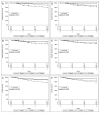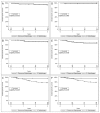HLA class I and II expression in oropharyngeal squamous cell carcinoma in relation to tumor HPV status and clinical outcome
- PMID: 24130830
- PMCID: PMC3794938
- DOI: 10.1371/journal.pone.0077025
HLA class I and II expression in oropharyngeal squamous cell carcinoma in relation to tumor HPV status and clinical outcome
Abstract
HPV-DNA positive (HPVDNA+) oropharyngeal squamous cell carcinoma (OSCC) has better clinical outcome than HPV-DNA negative (HPVDNA-) OSCC. Current treatment may be unnecessarily extensive for most HPV+ OSCC, but before de-escalation, additional markers are needed together with HPV status to better predict treatment response. Here the influence of HLA class I/HLA class II expression was explored. Pre-treatment biopsies, from 439/484 OSCC patients diagnosed 2000-2009 and treated curatively, were analyzed for HLA I and II expression, p16(INK4a) and HPV DNA. Absent/weak as compared to high HLA class I intensity correlated to a very favorable disease-free survival (DFS), disease-specific survival (DSS) and overall survival (OS) in HPVDNA+ OSCC, both in univariate and multivariate analysis, while HLA class II had no impact. Notably, HPVDNA+ OSCC with absent/weak HLA class I responded equally well when treated with induction-chemo-radiotherapy (CRT) or radiotherapy (RT) alone. In patients with HPVDNA- OSCC, high HLA class I/class II expression correlated in general to a better clinical outcome. p16(INK4a) overexpression correlated to a better clinical outcome in HPVDNA+ OSCC. Absence of HLA class I intensity in HPVDNA+ OSCC suggests a very high survival independent of treatment and could possibly be used clinically to select patients for randomized trials de-escalating therapy.
Conflict of interest statement
Figures



Similar articles
-
Absent/weak CD44 intensity and positive human papillomavirus (HPV) status in oropharyngeal squamous cell carcinoma indicates a very high survival.Cancer Med. 2013 Aug;2(4):507-18. doi: 10.1002/cam4.90. Epub 2013 Jun 14. Cancer Med. 2013. PMID: 24156023 Free PMC article.
-
Combined analysis of HPV-DNA, p16 and EGFR expression to predict prognosis in oropharyngeal cancer.Int J Cancer. 2007 Apr 15;120(8):1731-8. doi: 10.1002/ijc.22355. Int J Cancer. 2007. PMID: 17236202
-
Human papillomavirus and p53 expression in cancer of unknown primary in the head and neck region in relation to clinical outcome.Cancer Med. 2014 Apr;3(2):376-84. doi: 10.1002/cam4.199. Epub 2014 Feb 10. Cancer Med. 2014. PMID: 24510528 Free PMC article.
-
HPV-positive head and neck tumours, a distinct clinical entity.B-ENT. 2015;11(2):81-7. B-ENT. 2015. PMID: 26563006 Review.
-
From HPV-positive towards HPV-driven oropharyngeal squamous cell carcinomas.Cancer Treat Rev. 2016 Jan;42:24-9. doi: 10.1016/j.ctrv.2015.10.009. Epub 2015 Oct 31. Cancer Treat Rev. 2016. PMID: 26547133 Review.
Cited by
-
Protein Expression in Tonsillar and Base of Tongue Cancer and in Relation to Human Papillomavirus (HPV) and Clinical Outcome.Int J Mol Sci. 2018 Mar 25;19(4):978. doi: 10.3390/ijms19040978. Int J Mol Sci. 2018. PMID: 29587383 Free PMC article.
-
Tumor-associated B cells and humoral immune response in head and neck squamous cell carcinoma.Oncoimmunology. 2019 Jan 10;8(3):1535293. doi: 10.1080/2162402X.2018.1535293. eCollection 2019. Oncoimmunology. 2019. PMID: 30723574 Free PMC article.
-
Therapeutic options for human papillomavirus-positive tonsil and base of tongue cancer.J Intern Med. 2025 Jun;297(6):608-629. doi: 10.1111/joim.20088. Epub 2025 Apr 17. J Intern Med. 2025. PMID: 40246777 Free PMC article. Review.
-
Prognostic Markers and Driver Genes and Options for Targeted Therapy in Human-Papillomavirus-Positive Tonsillar and Base-of-Tongue Squamous Cell Carcinoma.Viruses. 2021 May 14;13(5):910. doi: 10.3390/v13050910. Viruses. 2021. PMID: 34069114 Free PMC article. Review.
-
Human papillomavirus and tonsillar and base of tongue cancer.Viruses. 2015 Mar 20;7(3):1332-43. doi: 10.3390/v7031332. Viruses. 2015. PMID: 25803099 Free PMC article. Review.
References
Publication types
MeSH terms
Substances
LinkOut - more resources
Full Text Sources
Other Literature Sources
Research Materials

